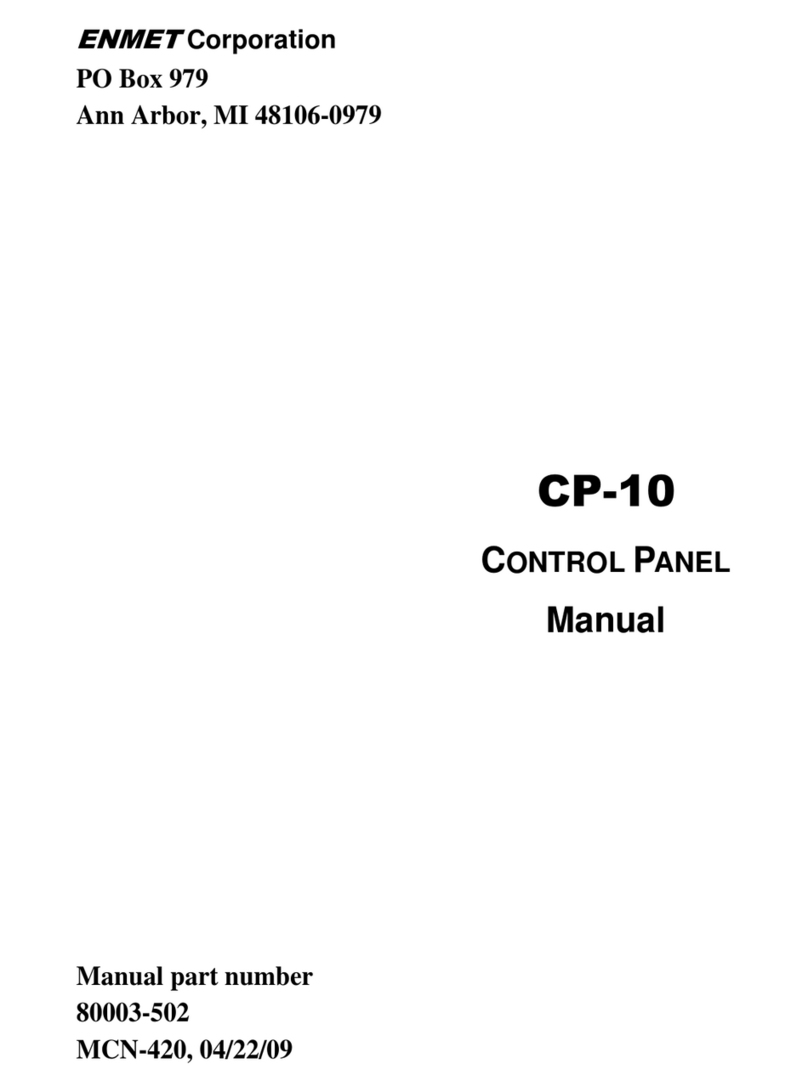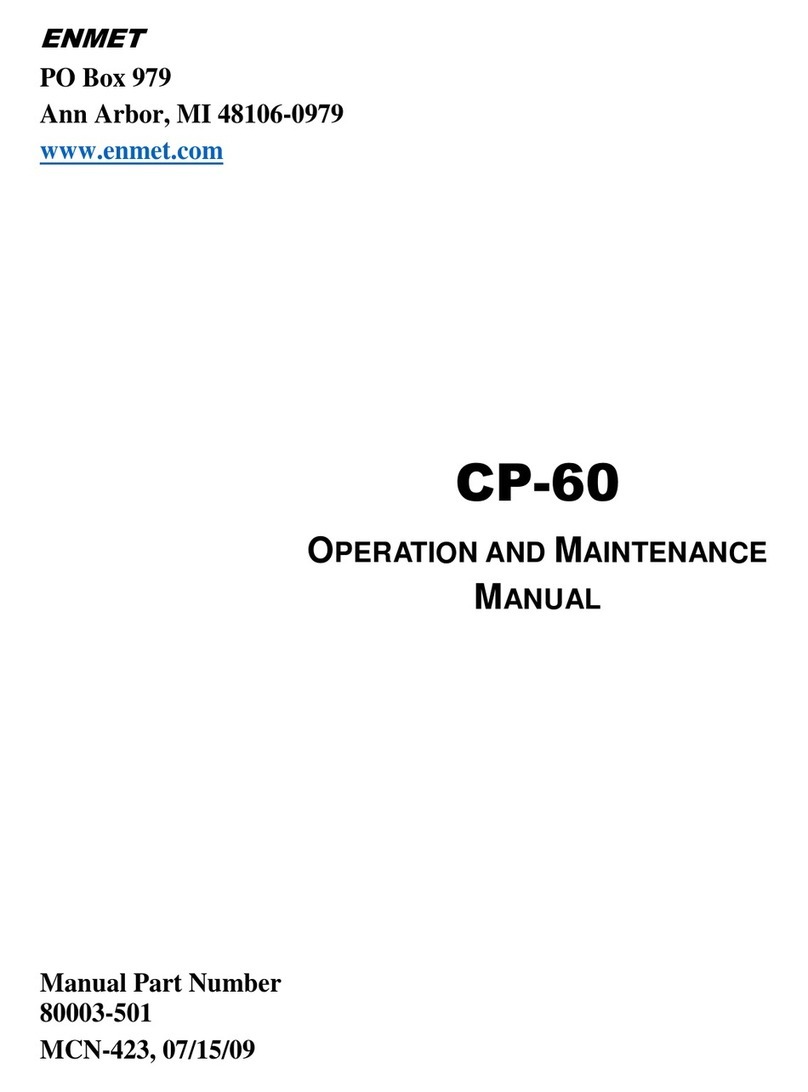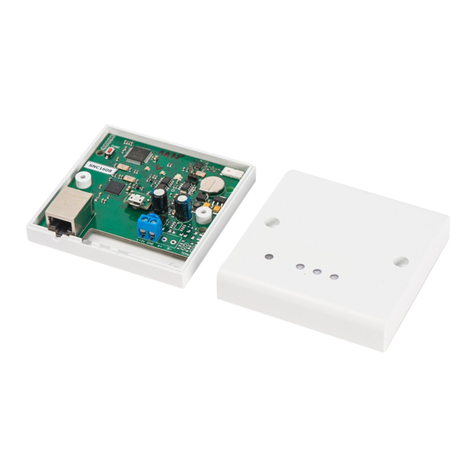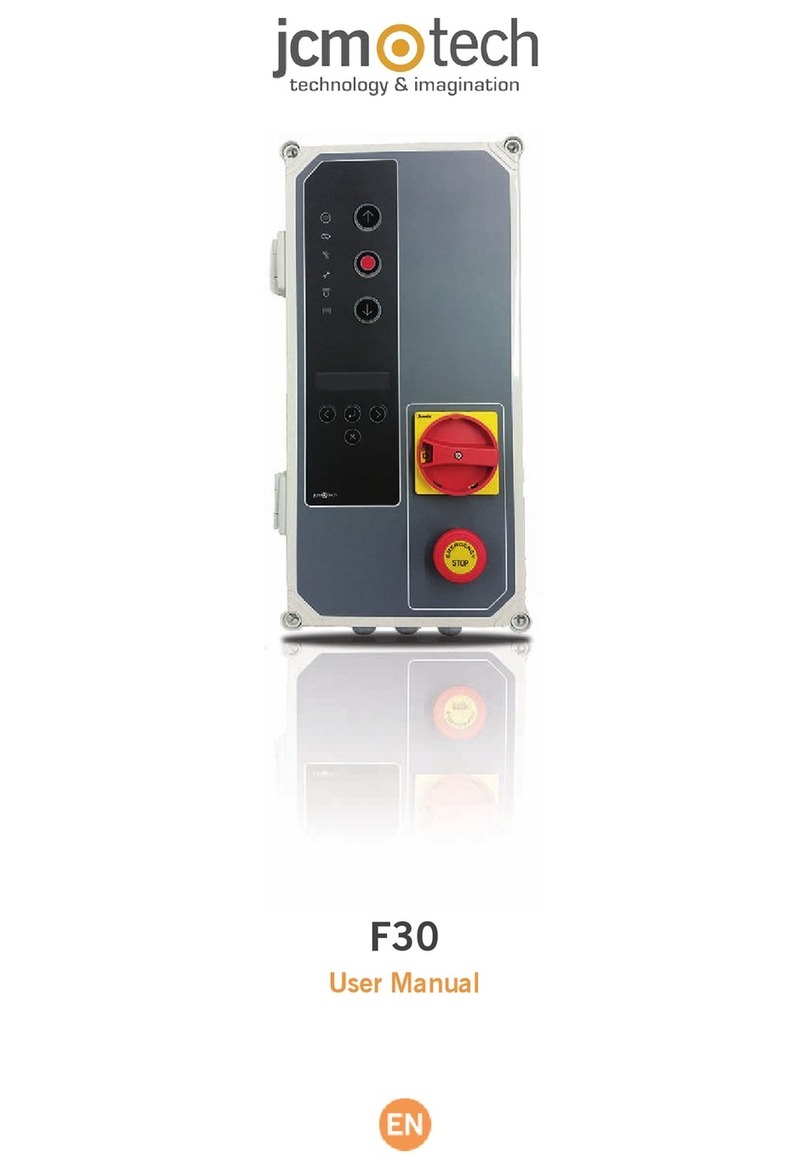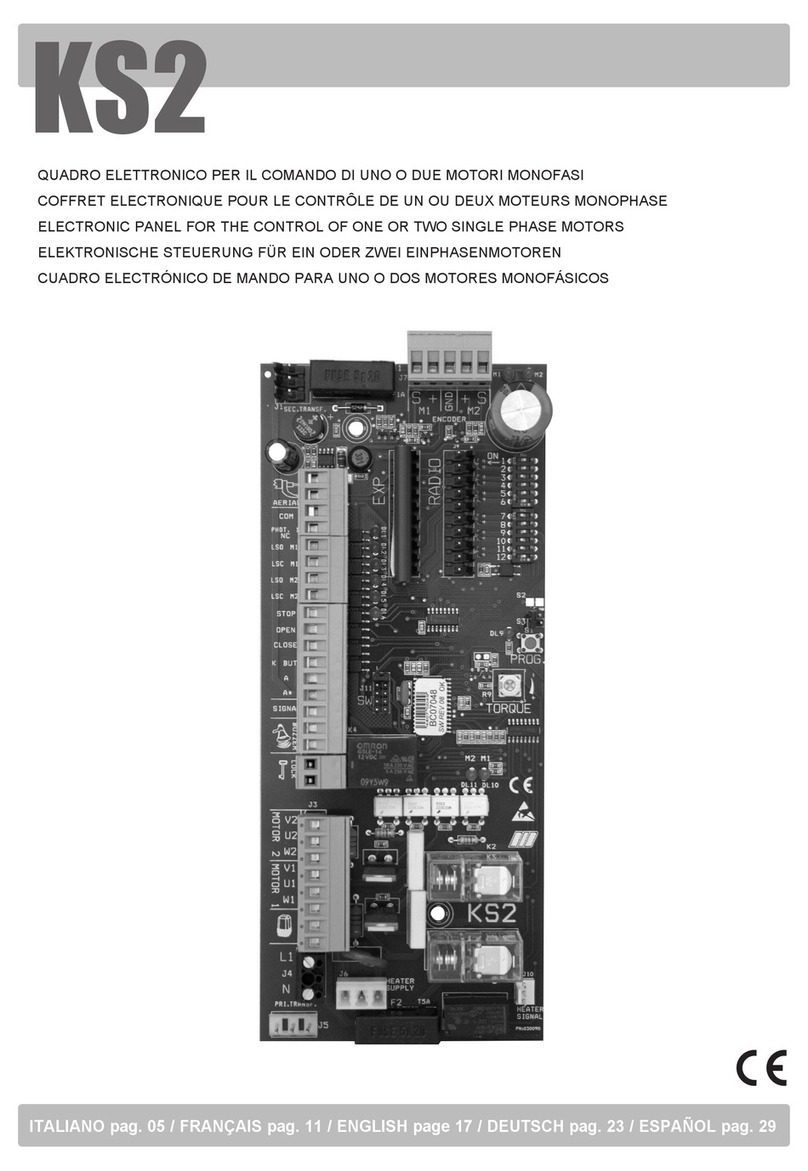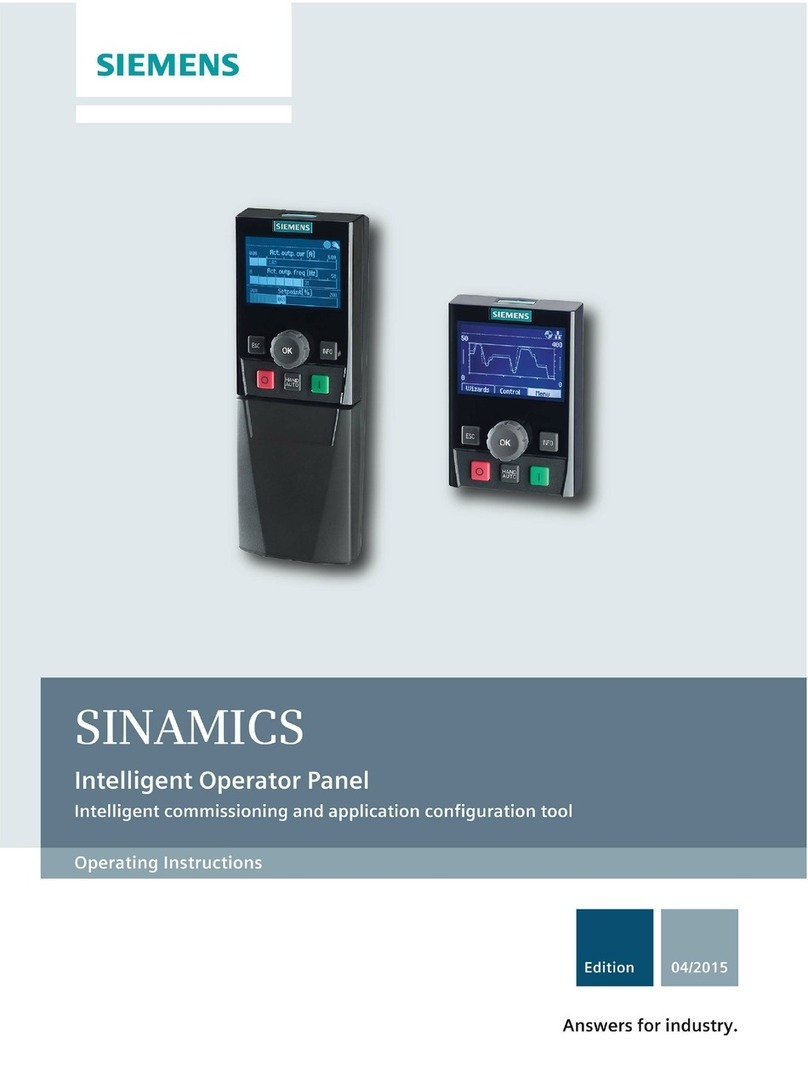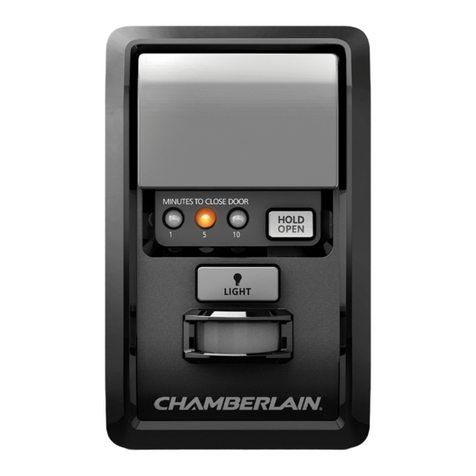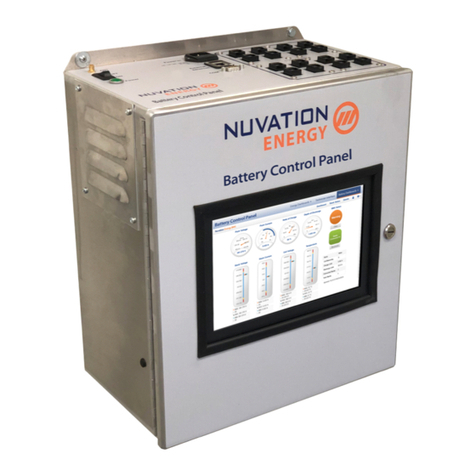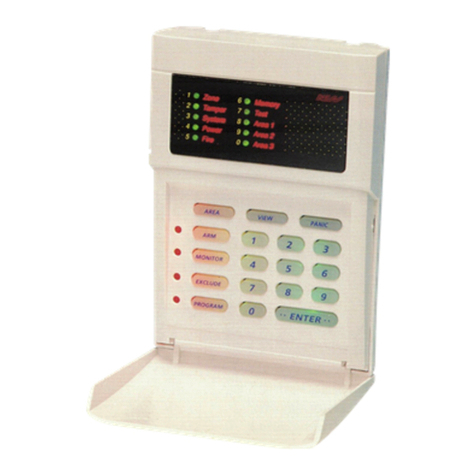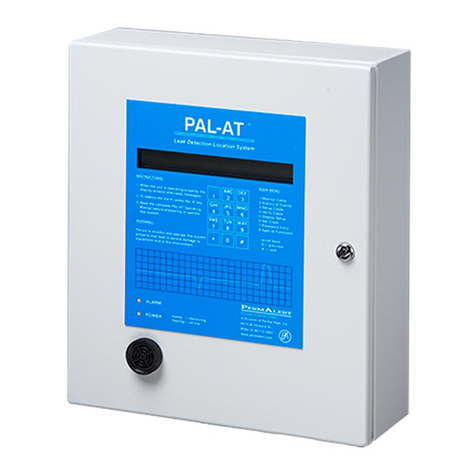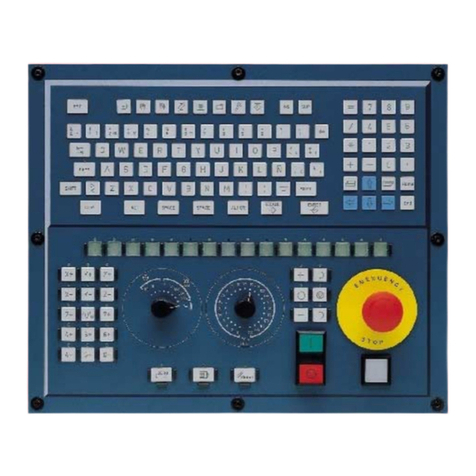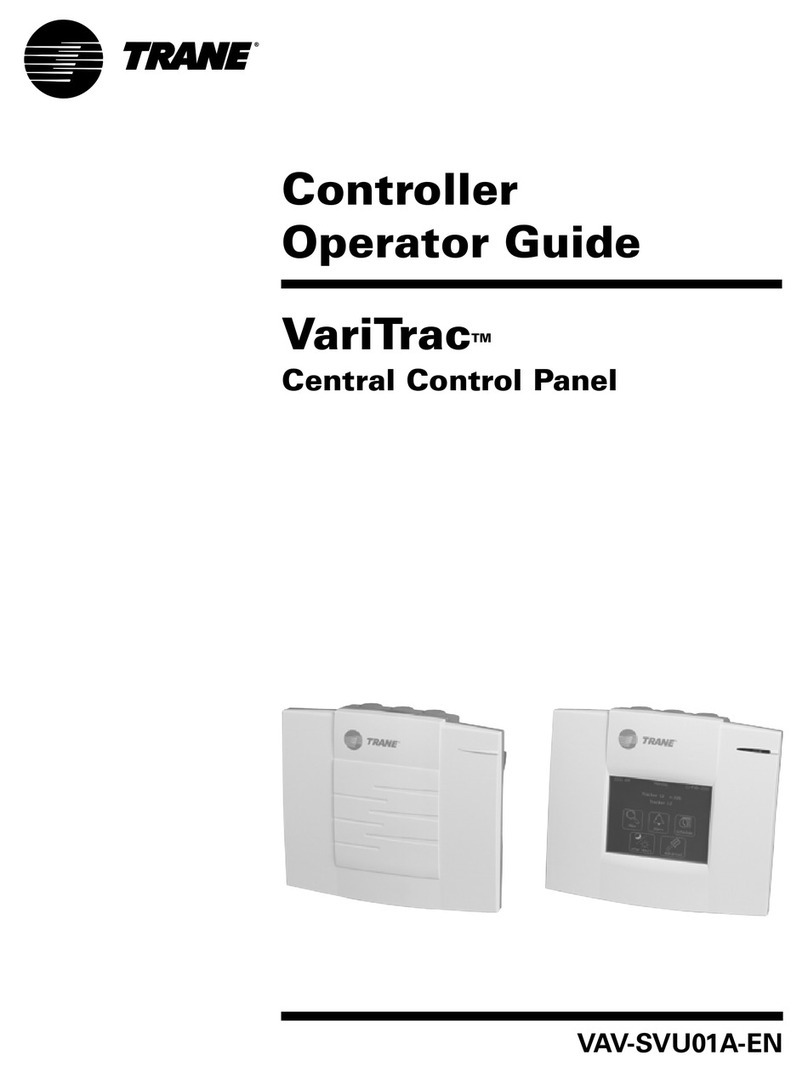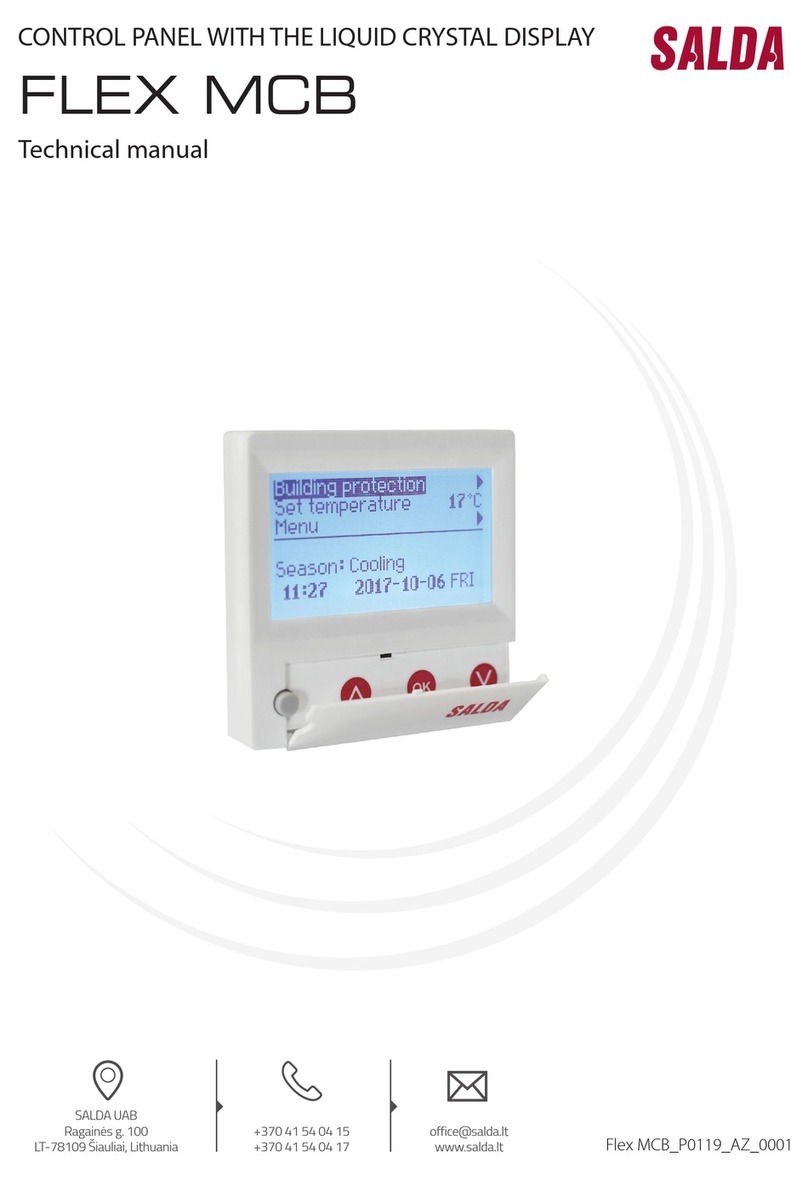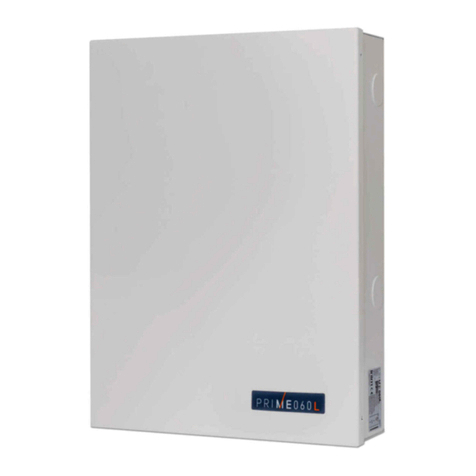ENMET ISA-60M User manual

ENMET Corporation
PO Box 979
Ann Arbor, MI 48106-0979
www.enmet.com
Manual Part Number
80003-500
MCN-13-002, 04/29/13
ISA-60M
with MRI-5175
O
PERATION AND
M
AINTENANCE
M
ANUAL
Andersen Medical Gas
12 Place Lafifitte
Madisonville, LA 70447
https://www.TheMedicalGas.com
https://www.Shop.TheMedicalGas.com
1-866-288-3783

Table of Contents
1.0 Introduction..............................................................................................................................................................................1
1.1 IEC 60601-1 Classifications ................................................................................................................................................1
1.2 Unpack.................................................................................................................................................................................1
1.3 Check Order.........................................................................................................................................................................1
1.4 Serial Numbers.....................................................................................................................................................................1
2.0 Instrument Features..................................................................................................................................................................2
2.1 ISA-60M Exterior Features..................................................................................................................................................2
2.2 Display ISA-60M Front Panel Features...............................................................................................................................2
2.3 MRI-5175 Exterior Features................................................................................................................................................2
2.3 Circuit Board Features.........................................................................................................................................................4
3.0 Installation ...............................................................................................................................................................................5
3.1 Mounting of Instrument.......................................................................................................................................................5
3.2 Mounting MRI-5175 Remote Sensor...................................................................................................................................5
3.3 Power Supply.......................................................................................................................................................................6
3.4 Wiring ISA-60M to MRI-5175............................................................................................................................................6
3.4.1 Outputs..........................................................................................................................................................................6
3.4.2 ISA-60M Relay Contacts..............................................................................................................................................7
3.4.3 4-20mA Outputs............................................................................................................................................................8
3.4.4 Digital Outputs..............................................................................................................................................................8
3.5 Initial Calibration.................................................................................................................................................................8
4.0 Operation .................................................................................................................................................................................9
4.1 Normal Operation Condition ...............................................................................................................................................9
4.2 Alarm Set Points ..................................................................................................................................................................9
4.3 Fault Indications...................................................................................................................................................................9
4.4 Alarm Latching....................................................................................................................................................................9
4.5 Audio Defeat........................................................................................................................................................................9
4.6 Display...............................................................................................................................................................................10
4.7 Operational Menu ..............................................................................................................................................................10
5.0 Maintenance...........................................................................................................................................................................11
5.1 Cleaning Instructions .........................................................................................................................................................11
5.2 Maintenance Menu ISA-60M ............................................................................................................................................11
5.2.1 Set 4 –20mA Transmitter Scale ..................................................................................................................................12
5.2.2 MRI-5175 Calibration.................................................................................................................................................12
5.2.3 Standard Calibration ...................................................................................................................................................12
5.2.4 Altitude Calibration.....................................................................................................................................................12
5.2.5 ISA-60M Controller....................................................................................................................................................13
5.2.6 Set Alarm Points .........................................................................................................................................................14
5.2.7 Set Alarm “Delay On” ................................................................................................................................................16
5.2.8 Relay Configuration....................................................................................................................................................16
5.2.9 Failsafe Configuration.................................................................................................................................................17
5.2.10 Set New Password.....................................................................................................................................................17
5.2.11 Exit Maintenance Menu............................................................................................................................................18
5.3 MRI-5175 Sensor Transmitter ...........................................................................................................................................18
5.4 Channel Activation/Deactivation.......................................................................................................................................18
6.0 Maintenance MRI-5175.........................................................................................................................................................19
6.1 MRI-5175 Calibration........................................................................................................................................................19
6.1.1 Standard Calibration ...................................................................................................................................................19
6.1.2 Altitude Calibration.....................................................................................................................................................19
6.2 Sensor Replacement...........................................................................................................................................................21
7.0 Technical Data and Specifications.........................................................................................................................................22
8.0 Replacement Part Numbers....................................................................................................................................................23
9.0 WARRANTY ........................................................................................................................................................................23

List of Figures
Figure 1: ISA-60M & MRI-5175 External Features...................................................................................................3
Figure 2: ISA-60M Interior Features ..........................................................................................................................4
Figure 3: ISA-60M Mounting Dimensions.................................................................................................................5
Figure 4: MRI-5175 REMOTE SENSOR Mounting Dimensions....................................................................................5
Figure 5: ISA-60M Relay, Input and Output Terminals.............................................................................................6
Figure 5A: MRI-5175 Input and Output Terminals....................................................................................................7
Figure 6: ISA-60M Operational Display.....................................................................................................................9
Figure 7: ISA-60M Operation Menu Flow Chart......................................................................................................10
Figure 8: ISA-60M Maintenance Menu Flow Chart.................................................................................................11
Figure 9: Calibration MRI-5175...............................................................................................................................13
Figure 9: Calibration MRI-5175...............................................................................................................................20
Figure 10: MRI-5175 Sensor Replacement...............................................................................................................21
List of Tables
Table 1: Wiring ISA-60M to MRI-5175.......................................................................................................................7
Table 2 : Relay Failsafe Settings...................................................................................................................................7
Table 5: Fault LED Code Sequence............................................................................................................................13
Table 3: Set up values.................................................................................................................................................13
Table 4: Default Relay Links......................................................................................................................................16
Table 5: Fault LED Code Sequence............................................................................................................................20
Reference Information:
NOTE:[important information about use of instrument]
CAUTION:[affects equipment – if not followed may cause damage to instrument, sensor etc…]
W
ARNING
:
[affects personnel safety – if not followed may cause bodily injury or death.]
Attention / Warning
Earth Ground
!

ISA-60M ENMET Corporation
1
1.0 Introduction
The ISA-60M W/MRI-5175 is an ambient air monitoring system that measures oxygen concentrations in magnetic resonance
imaging environments. The ISA-60M control panel is capable of monitoring from 1 to 3 MRI-5175 remote sensors. Note: The
ISA-60M and MRI-5175 are produced as an aligned set and should be installed as such. Some features of the monitoring
system are as follows:
continuous monitoring of the sample air
continuous LCD display oxygen concentrations, at ISA-60M
menu driven operational and maintenance controls
menu driven calibration procedure
audio and visual alarms indicate unsafe conditions
alarm relay contacts available on terminals
a fault relay and visual fault alarm
alarm acknowledgement capability including audio defeat
mA output for each channel
N
OTE
:All specifications stated in this manual may change without notice.
1.1 IEC 60601-1 Classifications
Type of protection against electrical shock: Class 1.
Degree of protection against electrical shock: No Applied Parts
- Equipment not suitable for use in presence of flammable anesthetic mixture with air or with oxygen or nitrous oxide.
- Mains power quality should be that of a typical commercial or hospital environment.
- Power frequency magnetic fields should be at levels characteristic of a typical location in a commercial or hospital
environment.
1.2 Unpack
Unpack the
ISA-60M
and examine it for shipping damage. If such damage is observed, notify both ENMET customer service personnel and
the commercial carrier involved immediately.
Regarding Damaged Shipments
NOTE:It is your responsibility to follow these instructions. If they are not followed, the carrier will not honor any
claims for damage.
This shipment was carefully inspected, verified and properly packaged at our company and delivered to the carrier in good condition.
When it was picked up by the carrier at ENMET, it legally became your company’s property.
If your shipment arrives damaged:
•Keep the items, packing material, and carton “As Is.” Within 5 days of receipt, notify the carrier’s local office and request
immediate inspection of the carton and the contents.
•After the inspection and after you have received written acknowledgment of the damage from the carrier, contact ENMET
Customer Service for return authorization and further instructions. Have your Purchase Order and Sales Order numbers available.
ENMET either repairs or replaces damaged equipment and invoices the carrier to the extent of the liability coverage, usually $100.00.
Repair or replacement charges above that value are your company’s responsibility.
The shipping company may offer optional insurance coverage. ENMET only insures shipments with the shipping company when
asked to do so in writing by our customer. If you need your shipments insured, please forward a written request to ENMET Customer
Service.
Regarding Shortages
If there are any shortages or questions regarding this shipment, please notify ENMET Customer Service within 5 days of receipt at the
following address: ENMET Corporation
680 Fairfield Court
Ann Arbor, MI 48108
734-761-1270 734-761-3220 Fax
1.3 Check Order
Check, the contents of the shipment against the purchase order. Verify that the
ISA-60M
is received as ordered. If there are accessories on
the order, ascertain that they are present. Check the contents of calibration kits. Notify ENMET customer service personnel of any
discrepancy immediately.
1.4 Serial Numbers
Each
ISA-60M
and
MRI-5175
is serialized. These numbers are on tags on the equipment and are on record in an ENMET database.

ISA-60M ENMET Corporation
2
2.0 Instrument Features
2.1 ISA-60M Exterior Features
The exterior of the instrument is shown in Figure 1. The exterior features are as follows:
Feature Description
Enclosure Engineered thermoplastic, approximately 11x9x6, with a clear hinged front cover.
Strain Relief Entrance for wiring to Remote Sensor
Input Port The entrance for the calibration gas. The quick release fitting mates with one on the
calibration adapter.
Audio Alarm A loud horn activated by certain alarm conditions.
Mounting Flanges Flanges with holes for mounting the enclosure to a vertical surface.
2.2 Display ISA-60M Front Panel Features
The display panel, shown in Figure 1, is viewed through the clear front cover of the enclosure, and is accessed by opening the
cover. Features are as follows:
Feature Description
Display 2 line, 16 character per line, LCD with backlight.
The numerical values of gas concentrations, and other information are displayed.
Visual
Alarms & Indicators On either sides of the display:
A red alarm LED for each sensor transmitter installed to the instrument, Alarm 1.
The top center:
A red alarm LED for all sensor transmitters, Alarm 2.
Near the center of the panel:
A green power indicator LED
A red fault alarm LED
Pushbutton Switches There are three of these, located near the center of the panel; they are yellow
rectangular membrane switches. They are:
•OPTION Switch The top left switch.
•SELECT Switch Directly to the right of the OPTION switch.
•AUDIO DEFEAT /
ALARM ACKNOWLEDGE
Switch
Directly below the OPTION switch.
2.3 MRI-5175 Exterior Features
The exterior and panel of the sensor/transmitter is shown in Figure 1. The MRI-5175 features are as follows:
Feature Description
Enclosure Fiberglass-reinforced polyester approximately 5” square, with
non-magnetic hardware.
Strain Relief Entrance for wiring to ISA-60M control unit
Mounting Flanges Flanges with holes for mounting the enclosure to a vertical surface.
MENU Switch The left most pushbutton switch
SELECT Switch The right most pushbutton switch
Power/Fault LED Red/Green LED, Green indicating power on and red indicating a fault condition
Visual Alarm LED 3 Red LED, Triggered at level of alarm
Sensor Long life electrochemical oxygen sensor
Audio Alarm
(Optional) A loud horn activated by certain alarm conditions.
Menu
Select

ISA-60M ENMET Corporation
3
Figure 1: ISA-60M & MRI-5175 External Features
Strain Relief
Power/Fault LED
Audio Alarm
(Optional)
Visual O2
Alarm LED
MENU
Switch
SELECT
Switch
Sensor
Mounting Flanges
4 places
Menu
Select
SN:
-XXXX
88
Power/Fault XXX XXX XXX
%O2 by vol.
O
2
%
O
2
%
Display
Front Cover Latch
Audio Alarm
Fault LED
SELECT
Switch
Power LED
OPTION
Switch
Alarm Defeat
/
Alarm Acknowledge
Switch
Visual Alarm
O
2
Mounting Flanges
2 places
Visual Alarm
(If additional MRI-
5175
remote sensors are
connected)
Punch out/Hole Plug
For External Wiring
2 places
Strain Relief
Alarm 2

ISA-60M ENMET Corporation
4
2.3 Circuit Board Features
The Display Panel is hinged on the left and is released by unscrewing the 2 philips screws located in the top and bottom right
corners. After releasing the panel, it is swung to the left, exposing the interior of the enclosure. The Circuit Board is mounted
on a plate at the back surface of the enclosure interior. Features are shown in Figure 2.
Feature Description
Relay Terminals This group of terminals is located at the left side of the Circuit Board.
For the contacts for each of four alarm relays, and for the contacts of a fault relay.
Output Terminals There are two for each of the 4-20 mA outputs.
Figure 2: ISA-60M
Interior Features
Power Input
Terminal J23
Audio
Alarm
Relay Terminals
(6 places)
Aux Terminals
Optional (2 places)
Primary Detector
Channel 1
Horn Terminal
4
–
20mA Output
Terminals
4 outputs
2 connectors
Fuse Holder
Digital Communication
Terminals (3 types)
Ground Screw J21
Hole Plugs
(2 places)
Strain Relief

ISA-60M ENMET Corporation
5
3.0 Installation
3.1 Mounting of Instrument
Mount the ISA-60M instrument on an appropriate vertical surface using the mounting flanges provided. Avoid areas with
excessive vibration or temperature extremes. The holes in the flanges are 0.31 inch in diameter and form a 6 x 10.75 inch
rectangle. See Figure 3.
It is recommended to use #8 drywall anchors and screws for mounting the ISA-60M to a drywall/sheetrock surface.
Non-magnetic mounting hardware is required for control panels located in the magnet room.
Dimensions are in inches.
Figure 3: ISA-60M
Mounting Dimensions
3.2 Mounting MRI-5175 Remote Sensor
Mount each MRI-5175 remote sensor such that is samples the ambient air in the MRI environment.
It is recommended to use #8 drywall anchors and screws for mounting the ISA-60M to a drywall/sheetrock surface.
Non-magnetic mounting hardware is required.
Dimensions are in inches.
N
OTE
: Remote Sensor, Each must be
connected to a 4-20mA input inside the
ISA-60M. UL listed type CM, PLTC or
TC cable shall be used for wiring between
the MRI-5175 and the ISA-60M control
panel. Three-conductor, 18 gauge
shielded
wiring for runs up to 1000 feet.
For 500 feet or shorter wiring runs, 20
gauge
shielded
wiring is acceptable. The
supplied strain reliefs are rated for cable
with an OD between 0.20 – 0.35 inches.
Refer to Section 7 for Technical Instillation
Data.
Figure 4: MRI-5175
R
EMOTE
S
ENSOR
Mounting Dimensions
Mounting Holes
0.31” dia. 4 places
!
!
Side View
Typical location of Strain Relief
Menu
Select
SN:
-XXXX
Front View
Mounting Holes R 0.28” dia. 4 places

ISA-60M ENMET Corporation
6
3.3 Power Supply
The input power can vary from 100 to 240VAC, 50/60 Hz. Mains power should be connected to the Power Input Terminal J23
and the ground screw J21. See Figure 5 for location.
W
ARNING
:
Continuous gas detection and alarm systems become inoperative upon loss of primary power.
Upon supplying air and power to the ISA-60M:
The green power on LED is lit.
The display backlight is lit, and instrument will step through a start-up sequence: unit serial number, software revision
and gases monitored may be shown on the display.
The instrument may go into alarm briefly, but the sensors stabilize quickly. If the instrument persists in alarm, acknowledge the
alarm by pressing the AUDIO DEFEAT /ALARM ACKNOWLEDGE switch. If alarm persists longer than 30 minutes, call ENMET
customer service personnel.
Mains power line is fused for power supply protection. Fuse is 5 x20mm, 0.630Amp is located in FH2, see Figure 5
3.4 Wiring ISA-60M to MRI-5175
Wiring for the MRI-5175 alarm, relay contacts and 4-20mA outputs may be routed through one of the two enclosure punch-
outs on the side or bottom of the enclosure. See Figure 1. Follow state and local guidelines when selecting appropriate strain
relief, conduit and wiring.
Remote Sensor: Each must be connected to a 4-20mA input inside the ISA-60M. UL listed type CM, PLTC or TC cable shall
be used for wiring between the MRI-5175 and the ISA-60M control panel. Three conductor, 18 gauge
shielded
wiring for
runs up to 1000 feet. For 500 feet or shorter
shielded
wiring runs, 20 gauge wiring is acceptable. The supplied strain reliefs
are rated for cable with an OD between 0.20 – 0.35 inches. Refer to Section 7.0 for typical wiring information.
3.4.1 Outputs
Two types of alarm outputs are available, relay contacts and 4-20mA outputs.
Figure 5: ISA-60M Relay, Input and Output Terminals
Relay 1
Channel 1
Alarm 1
Relay 2
Channel 2
Alarm 1
Relay 3
Channel 3
Alarm 1
Relay 4
Channel 4
Alarm 1
Relay 5
Channel 1-4
Alarm 2
Relay 6
Ch 1-4 / System
Fault
J16 Detector Primary
Channel 1
J18 Connector
4-20mA Input
Channel 2
J19 Connector
4-20mA Input
Channel 3
Connector 2 (J4)
Channel 3 & 4
4-20mA Output
Connector 1 (J7)
Channel 1 & 2
4-20mA Output
Connector RS485
Connector RS232
Connector RS485
Power Input, Termi
nal J23
L-Line
N-Neutral
Ground Screw J21
Fuse Holder FH2
!

ISA-60M ENMET Corporation
7
Table 1: Wiring ISA-60M to MRI-5175
ISA-60M MRI-5175
Channel 1, J16
+24V (1)
GND (2)
mA (3)
Power
Ground
Signal
Channel 1, J4
+24V
GND
mA
Channel 2,
J18
+24V
GND
mA
Power
Ground
Signal
Channel 2
,
J4
+24V
GND
mA
Channel 3, J19
+24V
GND
mA
Power
Ground
Signal
Channel 3, J4
+24V
GND
mA
Figure 5A: MRI-5175 Input and Output Terminals
3.4.2 ISA-60M Relay Contacts
Relay contacts are available for each alarm; these are SPDT, rated at 10Amp at 110VAC or 10Amp at 30VDC for restive loads,
and may be latching or non-latching as required by the application. They are accessed on the terminals next to each relay see
Figure 2 & 5. The contact positions are noted on the circuit board next to each terminal.
These relay coils are energized when they are in the non-alarm state; the contact conditions given above are for the non-
energized state, which is identical to the alarm state.
In addition, there is a fault relay, which changes state whenever the instrument is in a fault condition. The contact positions are
noted on the circuit board next to each terminal. The coil of this relay is energized when the instrument is in the non-fault state;
the contact conditions given on the circuit board next to the terminal, are for the non-energized state, which is identical to the
fault state.
The PC Board is labeled for the relays in their un-energized state. If the relay is configured for failsafe, then this is also the alarm
condition state. Non-failsafe configured relays in the alarm state, are the reverse of the PC board labeling. Note that the
Fault(FLT) relay cannot be set to operate in a Non-Failsafe mode. Please see the Table 2 below:
Table 2 : Relay Failsafe Settings
Position
Failsafe
-
Alarm
Non
-
Failsafe
-
Alarm
J5 Relay 1 - NO Normally Open Normally Closed
J5 Relay 1 - COM Common Common
J5 Relay 1 - NC Normally Closed Normally Open
J6 Relay 2 - NO Normally Open Normally Closed
J6 Relay 2 - COM Common Common
J6 Relay 2 - NC Normally Closed Normally Open
J8 Relay 3 - NO Normally Open Normally Closed
J8 Relay 3 - COM Common Common
J8 Relay 3 - NC Normally Closed Normally Open
J10 Relay 4 - NO Normally Open Normally Closed
J10 Relay 4 - COM Common Common
J10 Relay 4 - NC Normally Closed Normally Open
J14 Relay 5 - NO Normally Open Normally Closed
J14 Relay 5 - COM Common Common
J14 Relay 5 - NC Normally Closed Normally Open
J15 Relay 6/FLT - NO Normally Open N/A
J15 Relay 6/FLT - COM Common N/A
J15 Relay 6/FLT - NC Normally Closed N/A
These relay contacts can be used to operate auxiliary alarms or other functions.
MRI-5175 Lid, interior view
(Optional)
D
–
D+
mA
GND
24V
J4

ISA-60M ENMET Corporation
8
3.4.3 4-20mA Outputs
Isolated 4-20 mA outputs are available for data logging or other purposes. An output is supplied for each sensor supplied in a
particular instrument, and can be added when a sensor is added in the field. These outputs are available on the Connector 1(J7)
for channels 1 & 2 and Connector 2(J4) for channels 3 & 4.
4mA corresponds to the sensor reading of 0 at the bottom of the range.
20mA corresponds to a full scale reading of 30.
Wiring requirements are the same as for the relays.
3.4.4 Digital Outputs
The RS232 & RS485 connections are used for firmware updates and digital communications. The ISA-60M is designed to
operate as a modbus slave. Contact the ENMET for further information on wiring for the digital outputs.
3.5 Initial Calibration
All instruments are calibrated at the factory. You may, if a calibration kit is available, calibrate the MRI-5175
3 – 4 hours after installation. See Section 5.0, Maintenance, for calibration instructions.

ISA-60M ENMET Corporation
9
4.0 Operation
4.1 Normal Operation Condition
With the ISA-60M installed as described in Section 3, and in clean air, the POWER green LED is on, the display is lit, and the
information on the display is as shown in Figure 6, for the sensor(s) installed in the ISA-60M.The red alarm and fault LEDs
are not lit.
Example of display
Figure 6: ISA-60M
Operational Display
4.2 Alarm Set Points
There are two alarm set points for each active oxygen channel. They are adjustable from 16.0 to 24.9. The standard factory
settings of these alarm set points are:
Alarm 1 is 19.5 % by volume, indicated by Flashing LED and audio alarm.
Alarm 2 is 17 % by volume, indicated by Steady LED and alarm 1 LED changes from flashing to steady.
These alarm set points can be changed within limits; see the maintenance section of this manual for the procedure.
If the oxygen content of the sample air decreases below an alarm set point, the associated red LED activates, the associated
relay changes state, and the audio alarm is activated.
Differential Setting (Non Factory)
Differential is an optional alarm relay configuration where when an alarm has been triggered, the relay will remain in alarm
state until the sensor reading has moved the differential “value” in the non-alarm direction. See example below.
The Alarm 1 differential value is the delay of the ISA-60M staying in alarm condition until after the measured reading has
returned past the alarm point by the differential value. Example: If the alarm point is
V
19.5 and the differential is 2, the
ISA-60M will go into alarm at 19.5 and stay in alarm until the reading has risen above 19.7.
CAUTION:Setting the alarm points to the differential setting disables the audio alarm for alarm point 1. The differential Setting
has no effect on alarm relays or on the audio alarm for alarm point 2.
4.3 Fault Indications
Fault indications are associated with sensor zero and calibration activities, and are described in the maintenance section 5.0 of
this manual.
4.4 Alarm Latching
An instrument is shipped with the alarms in the latching mode. The alarms may be independently configured in the non-
latching mode or differential setting by use of the maintenance menu. See Section 5.2.2, for setting alarm 1 and alarm 2.
Standard Setting
IN THE LATCHING MODE: at the cessation of the condition which causes an alarm, the alarm indications do not cease, and the
alarm relay contacts do not revert to the non-alarm state, until the ALARM ACKN/AUDIO DEFEAT switch is pressed. An
alarm can also be acknowledged by pressing the switch during the alarm condition; then at the cessation of the alarm
condition, alarm indications cease and alarm relays revert to the non-alarm state. After an alarm is acknowledged, alarms in
the latching configuration are re-armed to latch at the next alarm condition.
IN THE NON-LATCHING MODE:at the cessation of the condition that causes an alarm, the alarm indications automatically
cease, and the alarm relay contacts revert to the non-alarm state.
4.5 Audio Defeat
Pressing the AUDIO DEFEAT /ALARM ACKNOWLEDGE switch during an alarm temporarily silences the audio alarm on the ISA-
60M not on the MRI-5175. Relays and alarm LEDs continue to function, in the alarm state, during an alarm condition. As
long as the alarm condition persists, the audio alarm will “chirp” every 20 seconds. After the alarm condition clears, the audio
will continue to “chirp” until the audio switch is pressed.
If after 15 minutes the alarm condition continues the audio alarm will reactivate at full intensity.
If any other alarm condition occurs while the audio alarm has been silenced it will force the audio alarm to reactivate
immediately.
O2 20.9
O
2
%

ISA-60M ENMET Corporation
10
4.6 Display
In clean air a display is shown in Figure 4.This position of the display is termed the "operational display". As explained below,
the display can be changed to furnish other information by using the OPTION and SELECT switches.
Oxygen concentration is given in percent by volume.
4.7 Operational Menu
The operational menu allows the user to:
View alarm set point concentration values
View alarm latching configurations
Enter the maintenance menu with the proper Password.
The operational menu is accessed with the OPTION and SELECT switches. The operational menu flow chart is shown in
Figure 7,
Pressing the OPTION switch is indicated with a "O"
Pressing the SELECT switch is indicated with a "S".
If the instrument is left at any location in the operational or maintenance menus, other than the operational display, with no
action taken for a period of 45 seconds, it returns to the operational display.
Figure 7: ISA-60M
Operation Menu Flow Chart
S
S
O
O
O
S O = Press Option switch
S= Press Select switch
O
No
Function
O
No
Function
S
S
vL17 A2 v17
vD17
O
No
Function
S
See Maintenance Menu Diagram
O
Sfor each active channel
Displays are examples:
6– Indicates relay is engaged
Displays are examples of Alarms
Λ
- Indicates alarm triggered on increasing
value of reading
v - Indicates alarm triggered on decreasing
value of reading
Displays are examples of Alarms
L– Indicates alarm is in latching mode. Note:
Factory setting for alarms is latching
(no Lpresent) – Indicates alarm is in non-
latching mode.
Displays are examples of Alarms
D– Indicates alarm is in Differential Setting.
(no Dpresent) – Indicates alarm is in Standard
Setting.
O
S
No
Function
S
O
No
Function
Alternating
S
O
No
Function
CH-1 CH-3
CH-2
Relays 123456
6=ON
CH1 SCALE (O2)
0.0 – 30.0%
CH2 SCALE (O2)
0.00 – 30.0%
CH3 SCALE
(O2)
0.0 – 30.0 %
vL19.5 A1 vL19.5
vD 19.5
ALARM1 Delays
(Secon s)
30 mASPAN 30.0
30
5 5
5 5
Enter Password
_
Enter Maint Men

ISA-60M ENMET Corporation
11
5.0 Maintenance
The ISA-60M has no specific preventative maintenance requirements. Entering the maintenance menu, as outlined in Section
5.2 may change instrument configurations.
The MRI-5175 sensor will require periodic calibration and replacement. Oxygen sensor calibration should be preformed on at
least a quarterly basis. The sensor has an estimated lifetime of 5 years. The sensor should be replaced when it will not calibrate
or shortly before the 5 year time frame, to ensure continuous instrument operation. Sensor calibration instructions can be found
in Section 6.0.
5.1 Cleaning Instructions
CAUTION:Never spray a cleaning solution on the surfaces of the ISA-60M or MRI-5175 devices.
Clean the exterior of the ISA-60M and MRI-5175 enclosures with a mild soap solution on a clean, damp cloth. Do not soak
the cloth with solution so that moisture drips onto, or lingers on, external surfaces.
Under no circumstances should organic solvents such as paint thinner be used to clean instrument surfaces.
5.2 Maintenance Menu ISA-60M
The maintenance menu diagram is shown in Figure 8 Maintenance Menu Flow Chart. From the operational display, press
the OPTION switch 4 times; "Enter MAINTENANCE Menu" is displayed.
Figure 8: ISA-60M Maintenance Menu Flow Chart.
O = Press Option
S= Press Select
!

ISA-60M ENMET Corporation
12
5.2.1 Set 4 –20mA Transmitter Scale
This section of the maintenance menu is for aligning the external sensor/transmitters MRI-5175 to the ISA-60M controller.
This function is normally performed at the factory and is not usually required in the field unless a new transmitter is installed.
5.2.2 MRI-5175 Calibration
Calibration is performed at the MRI-5175 remote sensor/transmitter.
Calibration is the process of setting the instrument up to read accurately when exposed to a target gas.
Wait at least 3 – 4 hours after initially supplying power to the MRI-5175 sensor/transmitter before calibration, Overnight
stabilization is preferred before calibration. The MRI-5175 has been pre-calibrated at the factory, and initial field calibration
should result in only fine tuning the circuit, as well as a way to check that installation is successful. It is not necessary to open
the enclosure to make adjustment. The calibration functions are operated through the MENU and SELECT switches. See Table 5
for Power/Fault LED Sequence codes and Figure 9 Calibration MRI-5175.
5.2.3 Standard Calibration
The following procedure is suitable for altitudes below 4500 ft (1372 meters):
1. Press and hold the Menu switch for 3 to 5 seconds, the Power /Fault led will flash red- green, red- green, red- green….
2. Assemble the cylinder flow regulator and MRI calibration adapter.
To calibrate:
3. Press and release the Menu switch, then press and release the Select switch. This places the transmitter into the calibration
Span operation. The Power/ Fault led will flash Green-red-red-red, Green-red-red-red…
4. Attach the MRI calibration adaptor, part number 03620-021 to the sensor, then pull the trigger on the cylinder of 20.9%
Oxygen part number 03100-029 and partially inflate the bellows.
5. The MRI-5175 transmitter begins to look for signal stabilization; this process lasts from 60 to 120 seconds.
Observe the Power/ Fault led during this time. When the signal has stabilized, the Power/Fault led will show green for 3
seconds, indicating a successful calibration, and then flash red-green, red-green… If the calibration was unsuccessful,
following the 60 to 120 second stabilization time the Power/Fault led will show Red for 3 seconds and then flash red-green,
red-green, red-green…
6. Press and release the Select switch to exit calibration and return to operation mode. If the calibration was completed
successfully the Power/Fault led will show steady Green. If the calibration Failed the Power/Fault led will flash a Slow red-
green, red-green… Continue to flow the 20.9 Oxygen. Go to Section 5.2.5
5.2.4 Altitude Calibration
This procedure is required for altitudes above 4500 ft (1372 meters). Due to the reduction of partial pressure at elevations above
4500 ft (1372 meters), the following procedure must be used when installing the ISA-60M monitor. Subsequent calibration
should be done using the Standard calibration procedure as the compensation for partial pressure variances will have been
accomplished.
1. Press and hold the Menu switch for 3 to 5 seconds, the Power /Fault led will flash red- green, red- green, red- green…
2. Assemble the cylinder flow regulator and MRI calibration adapter.
To calibrate:
3. Press and hold the Menu switch for 3 to 5 seconds, the Power /Fault led will flash red, red, red, red …
4. Press and release the Menu switch then press and release the Select switch. This places the transmitter into the calibration
Span operation. The Power/ Fault led will flash Green-red-red-red, Green-red-red-red…
5. Attach the MRI calibration adaptor to the sensor, then pull the trigger on the cylinder and partially inflate the bellows.
6. The MRI-5175 transmitter begins to look for signal stabilization; this process lasts from 60 to 120 seconds.
Observe the Power/ Fault led during this time. When the signal has stabilized, the Power/Fault led will show green for 3
seconds, indicating a successful calibration, and then flash red-green, red-green and then red, red, red… If the calibration
was unsuccessful, following the 60 to 120 second stabilization time the Power/Fault led will show Red for 3 seconds and then
flash red-green, red-green, red-green…
7. Press and release the Select switch to exit calibration and return to operation mode. If the calibration was completed
successfully the Power/Fault led will show steady Green. If the calibration Failed the Power/Fault led will flash a Slow red-
green, red-green… Continue to flow the 20.9 Oxygen Go to Section 5.2.5
NOTE: After the initial Altitude Calibration, subsequent calibrations should be done following the Standard Calibration procedure.

ISA-60M ENMET Corporation
13
Table 5: Fault LED Code Sequence
Power/Fault LED Code Indication Sequence
Exit Green-red – green-red – green red-…
Span Green-red-red-red – green-red-red-red – green-red-red-red…
Cal OK Green for 3 seconds
Bad Cal Red for 3 seconds
Figure 9: Calibration MRI-5175
5.2.5 ISA-60M Controller
Entering a valid password into maintenance menu, the Scale mA Xmtrs section is the second menu section, if it is installed,
enter by pressing the SELECT switch
Press the SELECT switch "mA Xmter Scale: Select Ch1:O2" is displayed.
Press the OPTION switch, if needed, to change the channel to be set up.
Press the SELECT switch, “Ch#: mAXmter: 4mA: 00” is displayed
Press the SELECT switch, that moves the cursor one digit to the right when the last digit is accepted the display move to
the full Scale mA Xmtrs menu, the display reads
Press the SELECT switch, which moves the cursor one digit to the right when the last digit is accepted the display will
read “Ch#:O2 mAXmter NA Trim?”
Press the SELECT switch to enter. The display will read “O2:20.8, 3029,Trim Val:20.7?” (note this number will vary)
Press the SELECT switch, to move the cursor, use the OPTION switch to adjust the numbers to 20.9
Repeat these steps for each 4 –20mA transmitter.
Press the OPTION switch, to continue on to the next section of the Maintenance Menu.
Example:
Sensor/Transmitter Set Up Flow Chart
Table 3: Set up values
Gas
4mA
20mA
O
2
0 30
Power/Fault LED
MENU Switch
SELECT Switch
Calibration Cover
on Sensor
Menu
Select
Power/
Fault XXX
XXX
XXX
%O2 b yvol.
11Liter Aerosol
Gas
Cylinder Assembly
Calibration Cover
(03620-021)
Connection to
Calibration Cover
Flow Regulation Bellows
Valve/Regulator
(Included with Cylinder)
O
S
S
Calibration
Select O2
MAINTENANCE MENU
Scale
m
Xmtrs
O
Press
O
PTION
until the channel to be Set-
Up is displayed
CH1
O2 mA XMTER
4m
= 0.0
S
each digit
CH1
O2 mA XMTER
20mA
=
Seach digit
CH1: O2 mA
XMTER
mA Trim ?
O2 : 20.5 3030
Trim Val: 20.9
Trim OK
Trim Error
S
S
each
O
Ex
ample

ISA-60M ENMET Corporation
14
5.2.6 Set Alarm Points
Factory alarm set points are discussed in Section 4.2, See Table 2. To change the alarm points, you must enter the maintenance
menu.
NOTE:Changing the alarm points on the ISA-60M will NOT change the alarm points on the MRI-5175 sensor transmitter.
Entrance to the maintenance menu is guarded with a four-digit Password. The factory default setting of the password is 1270.
When a valid numerical password is inserted, the user is allowed to enter the maintenance menu.
In the "Enter Maint Menu" position
Press the SELECT switch "Enter Password T0" is displayed. Press SELECT switch once, to move cursor to next digit, this
will be the first digit of the password.
In the T000 position, the underline cursor is under the left digit.
Press the OPTION switch to change the left digit; select the correct digit.
Press the SELECT switch, which locks the digit in place and moves the cursor one digit to the right.
Continue this process until the four-digit password is complete. When a valid password is inserted in this manner, the display is
transferred to the "Calibration" portion of the menu. If an invalid password is inserted you are returned to the Enter Maint
Menu display.
After entering a valid password:
Press the OPTION switch until; “Maintenance Menu Set Alarm1” appears on display.
Press the SELECT switch, "ALARM1 Select: O2" is displayed.
Press the SELECT switch; "ALARM 1
V
" is displayed, with the indicator flashing,
Λ
for
ascending trigger point or
V
for descending trigger point indicator.
Press the OPTION switch to toggle between
Λ
and
V
; select the correct indicator.
Press the SELECT switch to lock in the correct indicator. "ALARM 1
STD
" is displayed
Press the OPTION switch to toggle between STD and
DIFF; select the correct indicator.
Press the SELECT switch to lock in the correct indicator.
IF: STD is selected, "ALARM 1
V
L" is displayed.
The next character is the latching indicator Lor NOLpress the OPTION switch to toggle the latching mode.
The next characters are the alarm 1 value, press the OPTION switch to select each digit of the value
When the last digit is accepted display returns to the Maintenance Menu "Set Alarm1" position.
IF: DIFF is selected, "ALARM 1
V DIFF 19.5
" is displayed, Factory default setting.
The next characters are the alarm 1 value, press the OPTION switch to select each digit of the value
Move the cursor to the first digit and, Press the SELECT switch to lock in the correct character and move the cursor to the
right.
"ALARM 1
DIFF BAND 0.0
" is displayed, to set alarm 1 differential. With SELECT switch move cursor to left.
Press the OPTION switch to select each digit of the value.
Note: The Alarm 1 differential value is the delay of the ISA-60M staying in alarm condition until after the measured reading
has returned past the alarm point by the differential value. Example: If the alarm set point is
V
19.5 and the differential is 2,
the ISA-60M will go into alarm at 19.5 and stay in alarm until the reading has risen above 19.7.
Repeat the above procedure for each sensor alarm 1 to be changed.
Press the OPTION switch to move to alarm 2, "Set ALARM2" is displayed.
Repeat as for alarm 1 using the STD section. Alarm Diff is not available for Alarm 2.
Press OPTION switch until “Exit maint menu” appears, then press SELECT switch to return the instrument to the Operational
Display
CAUTION:Setting the alarm points to the differential setting disables the audio alarm for alarm point 1. The differential Setting
has no effect on alarm relays or on the audio alarm for alarm point 2.

ISA-60M ENMET Corporation
15
Example: Set Alarms Flow Chart
Displays shown are factory default settings.
Λ -
Indicates alarm triggered on increasing value of reading
v
-
Indicates alarm triggered on decreasing value of reading
L-
Indicates alarm is set for latching
NO
L-
Indicates alarm is set for non-latching
STD – Indicates alarm in standard setting, can be set in latched or non-latched mode
DIFF – Indicates alarm in differential setting, instrument will stayin alarm beyond the alarmset point by the differential value
O = Press Option
S= Press Select
O
S
S
MAINTENANCE MENU
Set Alarm1
Alarm 1 -
Select: O2
v
STD
Alarm 1
O
S
Toggles status between Standard and
D
IFF
Locks selection
S
TD
S
Alarm 1 DIFF
BAND
0
00
v L–
1
9.5
Alarm 1
O
S
Changes character indicated
by underscore cursor
Locks underscored character and
moves cursor to next digit
DIFF
S
O
S
Changes character indicated by
underscore cursor
Locks underscored character and
moves cursor to next digit
v
T
Alarm 1
O
S
Toggles status between
Λ
increasing trigger and
v
decreasing trigger
Locks selection
S
V
T
L
Alarm 1
O
S
Toggles status between
Latching and Non Latching
Locks selection
Alarm 1
v
DIFF
1
9.5
O
S
Changes character indicated by
underscore cursor
Locks underscored character and
moves cursor to next digit
S
O
S
O
S
Alarm 2 -
Select:
XX
MAINTENANCE MENU
Set Alarm2
Changes character indicated by underscore cursor
Locks underscored character and moves cursor to next
O
Press
O
PTION
until the channel to be
Set
is displayed
Alarm 2
V
L
0
000

ISA-60M ENMET Corporation
16
5.2.7 Set Alarm “Delay On”
The alarms may be set to delay activation by 1 second increments.
Factory set default value is 5 seconds.
After entering a valid password:
Press the OPTION switch until; “Maintenance Menu Set Alarm Delay” appears on display.
Press the SELECT switch, "ALARM Delay Select: O2" is displayed.
Press the SELECT switch; "ALARM Delay = T005" is displayed, with the underscore cursor under the left position.
Press the SELECT switch to move the cursor and the OPTION switch to lock in the correct digit and move the cursor
one digit to the right. Press the SELECT switch when the last digit is accepted display returns to the "Set Alarm Delay"
position.
Press the OPTION switch to continue on to the Set New Password section
Example:
Set Alarm Delay Flow Chart
5.2.8 Relay Configuration
To change a relay configuration you must enter the maintenance menu. Press the OPTION switch until “Enter Maint Menu”
is displayed then press SELECT switch for the Enter Password menu. Enter the valid password as described below.
In the "Enter Maint Menu" position
Press the SELECT switch "Enter Password T0" is displayed. Press SELECT switch once, to move cursor to next digit,
this will be the first digit of the password.
In the T000 position, the underline cursor is under the left digit.
Press the OPTION switch to change the left digit; select the correct digit.
Press the SELECT switch, which locks the digit in place and moves the cursor one digit to the right.
Continue this process until the four-digit password is complete. When a valid password is inserted in this manner, the
display is transferred to the "Calibration" portion of the menu. If an invalid password is inserted you are returned to the
Enter Maint Menu display.
After entering a valid password:
Press the OPTION switch until “Configure Alarms” is displayed
L= Low Alarm = Alarm 1, H= High Alarm = Alarm 2, B= Both Alarms, = No Relay linked to channel
Example:
Set Relay Configuration Flow Chart
The Table 4 below shows the default relay links.
Table 4: Default Relay Links
Channel 1
Channel 2
Channel 3
Channel 4
Relay 1 Low Alarm
Relay 2 Low Alarm
Relay 3 Low Alarm
Relay 4 Low Alarm
Relay 5 High Alarm High Alarm High Alarm High Alarm
Relays can be linked to specific alarms.
NOTE:Each operating channel must be linked to at least 1 relay.
O
S
MAINTENANCE MENU
Set Alarm Delays
S
O
S
Alarm Delay -
Changes digit indicated by underscore cursor
Locks underscored digit and moves cursor to next digit
O
Press Option until the channel to be Set is displayed
Select:
XX
Alarm Delay -
0
000
O
S
MAINTENANCE MENU
Configure Alarms
S
O
S
Ch 1,2,3,4
Changes digit indicated by underscore cursor
Locks underscored digit and moves cursor to next digit
O
Press Option changes letter indicated by underscore cursor
R1
L
Ch 1 2 3 4
R2
L
O = Press Option
S= Press Select

ISA-60M ENMET Corporation
17
5.2.9 Failsafe Configuration
The ISA-60M is factory set in a failsafe configuration. This means that if power is disconnected to the unit, or the relay
fails to properly engage, it fails in such a way that it is in the alarm position. ENMET recommends leaving the relay in a
failsafe configuration. However, relay 1 – 5 can be re-configured by using the following procedure.
To change a relay failsafe configuration you must enter the maintenance menu. Press the OPTION switch until “Enter Maint
Menu” is displayed then press SELECT switch for the Enter Password menu. Enter the valid password as described below.
In the "Enter Maint Menu" position
Press the SELECT switch "Enter Password T0" is displayed. Press SELECT switch once, to move cursor to next digit,
this will be the first digit of the password.
In the T000 position, the underline cursor is under the left digit.
Press the OPTION switch to change the left digit; select the correct digit.
Press the SELECT switch, which locks the digit in place and moves the cursor one digit to the right.
Continue this process until the four-digit password is complete. When a valid password is inserted in this manner, the
display is transferred to the "Calibration" portion of the menu. If an invalid password is inserted you are returned to the
Enter Maint Menu display.
After entering a valid password:
Press the OPTION switch until “Relay Failsafes” is displayed
Example:
Set Relay Failsafe Configuration Flow Chart
5.2.10 Set New Password
To change the password, you must enter the maintenance menu. Press the OPTION switch until “Enter Maint Menu” is displayed
then press SELECT switch for the Enter Password menu. Enter the valid password as described in Section 5.2.1.
To set a new password, after inserting a valid password,
Press the OPTION switch until; "Set New Password” is displayed.
Press the SELECT switch; "Password T1270" is displayed, with the underscore cursor under the left digit.
Use the OPTION switch to change the left digit, when the desired digit is displayed.
Press the SELECT switch to lock the digit in place and move the cursor one digit to the right.
When all four digits of the new password have been selected, "Set New Password" is displayed.
Record the new password; without it, the maintenance menu cannot be reentered once you exit the Maintenance Menu. If the
password is lost, call ENMET customer service personnel.
From the "Password XXXX" position,
Press the SELECT switch to return to Set New Password section.
Press the OPTION switch; to continue to "exit MAINTENANCE Menu"
Example:
Set Password Flow Chart
O
S
MAINTENANCE MENU
Set New Password
Password
T
0000
O
S
Changes digit indicated by underscore cursor
Locks underscored digit and moves cursor to next digit
O = Press Option
S= Press Select
O
S
MAINTENANCE MENU
Relay
Failsafes
S
O
S
Relay
Failsafes
Changes
Failsafe setting from ON to OFF
Continue pressing S
ELECT
to cycle through all 5 relays
O
Pressing O
PTION
changes Failsafe setting from ON to OFF
R: 1 Failsafe ON
Relay
Failsafes
R: 2 Failsafe
OFF
O = Press Option
S= Press Select
Other manuals for ISA-60M
1
Table of contents
Other ENMET Control Panel manuals
